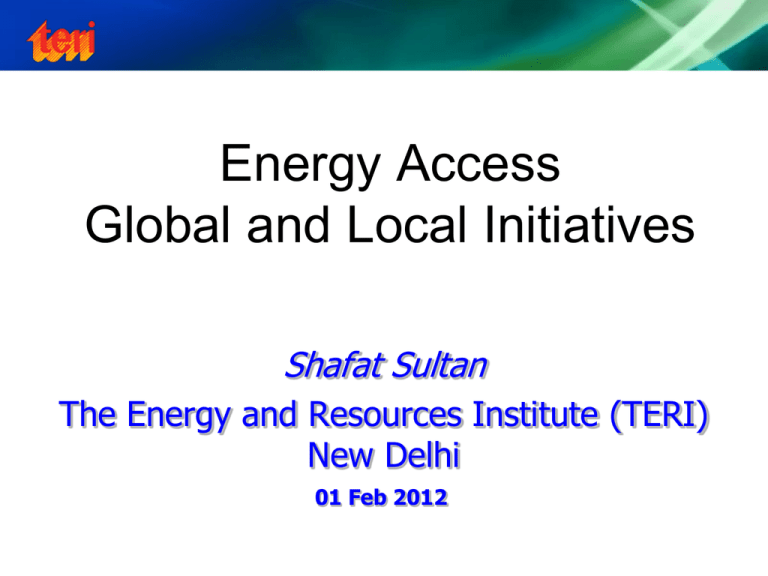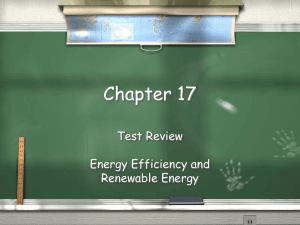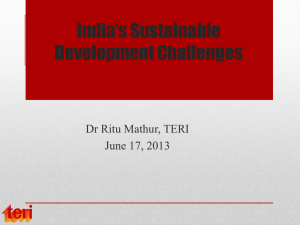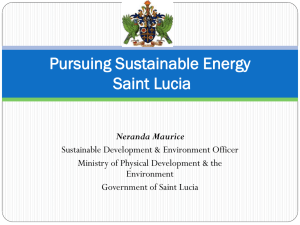Integrated RE Resource assessment for the state
advertisement

Energy Access Global and Local Initiatives Shafat Sultan The Energy and Resources Institute (TERI) New Delhi 01 Feb 2012 Current Lighting Scenario 1.4 billion people without basic lighting worldwide 360 million people in India -lack access to electricity • 61 million rural households -have no access to electricity and use kerosene for lighting • 2.2 billion litres per year -kerosene burned for lighting • Approx 5.5 million tonnes CO2 Lighting systems of more than one billion people 3 Cooking & Heating Energy : Current scenario • Traditional Biomass - primary source of energy for 2.4 billion people • Biomass - 11% contribution in the global final energy consumption (2001) – Latin America – 18% – Asia – 25% – Africa – 49% Cooking and heating systems of more than two billion United Nations’ Millennium Development Goals 2012- UN declared Int’l year of Sustainable Energy for AIl The UN MDGs are comprehensive and concrete goals adopted by world leaders and the international community. They provide a framework to address extreme poverty by the year 2015. Defining universal energy access Lighting Grid extension Mini grid access Cooking Off grid access Improved technology options for cooking Fuel switch for meeting thermal energy needs Traditional sources of cooking • Access = available + affordable • A mix of these options will be crucial in achieving universal energy access by 2030/35 Incremental levels of access to energy service Level 3 Modern society needs Level 2 Productive needs Level 1 Basic human needs Electricity for lighting, health education and communication and community services (73 kWh per person per month) Modern fuels and technologies for cooking and heating (50-100 kg of modern fuel or improved biomass cook stove) Electricity, modern fuels and other energy services to improve productivity e.g.: Agriculture: water pumping for irrigation, fertilizer, mechanized tilling Commercial agriculture processing, cottage industry Transport fuel Modern energy services for many more domestic appliances, increased requirement for cooking and heating (space and water), private transportation (electricity usage is 2000 kWh per person per year ) Steady move to clean energy resources at all stages Energy for a Sustainable Future the Secretary-General’s Advisory Group On Energy And Climate Change (AGECC) Summary Report And Recommendations, 28 April 2010, New York India’s Achievement in Renewable Energy Renewable Energy Programmes /Systems Cumulative Achievements as on 30th April 2011 1. Power from Renewable A. Grid Interactive Renewable Power Wind power Small hydro power Biomass power (agro-wastes/residues) Bagasse cogeneration Waste to power Solar power Subtotal (A) In MW 13065.78 2850.25 979.10 1494.53 72.46 17.82 18479.94 B. Off grid/Distributed enewable power(including captive/CHP plants) Biomass power/Cogeneration (Non-Bagasse) Biomass gasifiers U&I waste-to-energy Rural waste-to-energy Solar PV power plants and street lights(>1kW) Aero-generators/hybrid systems Subtotal (B) Total (A+B) Renewable Energy contributes 11.4 % in total energy generation in India 267.08 128.16 60.78 0.45 2.39 1.07 459.93 18939.87 Source : MNRE India’s Achievement in Renewable Energy Contd Renewable Energy Programmes/ Systems Cumulative Achievement as on 30th April 2011 2. Remote Village Electrification 3. Decentralised energy systems Family type biogas plants (in lakh) 6446 villages 43.10 SPV street lighting system (in nos.) 1,22,339 SPV home lighting system (in nos.) 6,69,400 SPV lanterns (in nos.) 8,13,380 SPV pumps (in nos.) 7495 SPV water heating-collector area (in million sq m) 3.53 Solar cookers (in lakh) 6.64 Wind pumps (in nos.) 1420 Source : MNRE Conducive Policy framework …Contd • Remote Village Electrification Program (2004) • Rajiv Gandhi Grameen Vidhyutikaran Yojana(2005) • Decentralized Distributed Generation (DDG) and Supply • Rural Household Electrification of Below Poverty Line Households • National Solar Mission • Create an enabling policy framework for the deployment of 20,000 MW of solar power by 2022 • Promote programmes for off grid applications, reaching 1000 MW by 2017 and 2000 MW by 2022 • Deploy 20 million solar lighting systems for rural areas by 2022 11 Solar Lighting Systems Solar Lantern Solar Home Lighting System Solar Street Lighting System Solar Home Lighting System Solar based Mini-Grid system in India Solar PV array Control room Battery Bank Local distribution grid Hybrid System at Sunderbans 55 kW Solar and 3.5kW Wind Electric Generator based hybrid system Wind Diesel hybrid system 15 A Typical LaBL Solar Charging Station LaBL Lanterns: In-house Research and Quality Control Designing and Customization LaBL Solar Charging Station (SLCS) One package = 50 lanterns Solar Mobile Charging 17 Cost of Illuminating a village with 50 lanterns (INR in Thousands) LaBL: Bringing Technology to the Masses LaBL Achievements across India 200,000 Lives Illuminated 700 Villages implemented >800 Green jobs created 40,000 households lit 17 States covered 75 training & capacity bldg workshops held -As of Sept 2011 Cooking and Heating • 3 billion people dependent on direct burning of biomass • Approx 150 million rural households adversely impacted by biomass based cooking in India •Close to 2 million people die globally due to indoor air pollution – chief cause of ALRI • Monitoring of IAP • A few thousand improved cook stoves installed • SHGs for manufacturing and marketing of stoves • Current commercial options cost around $40-$80 •Focus on cost reduction to bring it down to $ 20 • Focus on real time monitoring of cooking to claim C credits Metallic Cook stove in use Parabolic solar cooker TERI’s prototype ICs • • • • Single burner forced draft stove Double burner forced draft stove Efficiency – 35% Price – 2000 INR (40 % less than a commercial model with comparable performance) • Field trials • Customization of technology to facilitate transition in the cooking regime • Training of stove builders 21 Improved cook stove models Complexities • Adoption is difficult as it pertains to change in attitude and behaviour – Complex social, cultural and gender interactions – Affordability issues – makes technology development difficult • Environment an unlikely driver at the local level – more a development imperative • Motives for climate perspective not clearly understood – draw attention away from CO2 mitigation- not being taken forward in right earnest?? • Climate concerns have not led to any major investments or support for cook stove initiatives Way forward • Technology development – affordable and efficient options that meet global standards • Development of protocols, standards and benchmarks • Testing and certification systems • Recognition of BC mitigation in C trading • Setting up of financial mechanisms to support cook stove initiatives Bio resource base in India • Biomass production – 840 million tons (Firewood 220 million tons) (Agro residues 620 million tons) • Biomass at par with coal, but used inefficiently Overview of Biomass Technology Research at TERI • Power Gasifier – Rural electrification (10-40 kWe) – Captive generation (50-250 kWe) • Thermal Gasifier / Stove – About 12 biomass gasifier based packages developed – Oil replacement market – Energy Efficiency improvement • Bio-fuels – Technology development for ethanol production from ligno-cellulose material – Production of fuel oil from Biomass through Pyrolysis About LaBL ITP • Offers short term volunteering assignments 3 times a year (Summer; Autumn ; Winter) ; 4 weeks • Volunteers arranged in batches; Training/orientation provided • Assign a Point Person from the LaBL team to oversee work allocation • Undertake field / desk assignments and gain first-hand work experience ITP Enrollment: How? Call for Application Screening and Shortlisting Orientation & Training Point persons assigned Undertake assignments TERI’s Initiative: India’s First Smart Mini-Grid A. B. C. D. E. F. G. 10.5 kW crystalline SPV 1.0 kW Thin-film SPV 2.0 kW crystalline SPV 28.8 kWh Battery Bank 3.2 kW Wind Generator 100 kWe Biomass Gasifier Diesel Gen-set E B C A D F G Ensuring • Maximum utilization of renewable energy • Improvement in overall system efficiency • Better autonomy and control to customers • Intelligent load and energy resource management through smart controllers and advanced control techniques • Minimum network disruptions and number of blackouts Smart Mini-Grid at TERI GRIHA: Green Rating for Integrated Habitat Assessment Tool to facilitate design, construction, operation of a green building ,and in turn ….measure “greenness” of a building in India What gets measured gets managed Highlights Set of 34 criteria 100 (+4 innovation points) point system with differential weightage on various criteria 51 - 60 61 - 70 71 - 80 81- 90 91- 100 Weightage based on our National Priorities GRIHA innovation points over and above 100 points Key highlights of GRIHA • Sets out guidelines for design, construction and operation • Combination of qualitative and quantitative criteria • Sets performances benchmarks for key resources like, energy and water • Facilitates integration of traditional knowledge on architecture with present day technology • Integrates all relevant Indian codes and standards(e.g National building code 2005, Energy Conservation Building Code 2007, IS codes) • Is in complete alignment with government policies and programs (e.g Environmental clearance by the MoEF) ADaRSH (Association for Development and Research of Sustainable Habitats • ADaRSH is an independent society, registered under the Societies Act, 1860 • a platform for interaction on all relevant issues pertaining to sustainable habitats in the Indian context • Was founded jointly by MNRE (Ministry of New and Renewable Energy, Government of India) and TERI (The Energy & Resources Institute, New Delhi) along with some of the experts in the fields related to sustainability of builtenvironment from across the country • ADaRSH promotes and manages GRIHA – The National Rating System (Green Rating for Integrated Habitat Assessment) as a design and evaluation tool for green buildings and habitats, and administers the rating. Thank You 36










